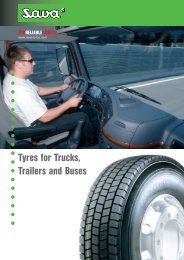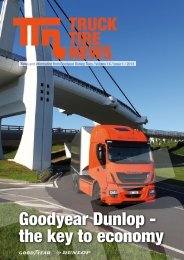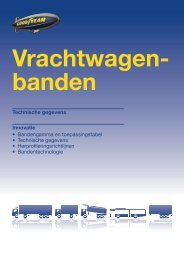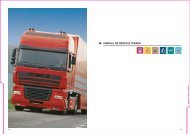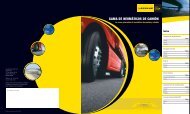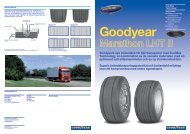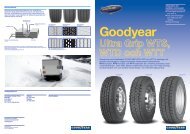FACTORS AFFECTING TRUCK FUEL ECONOMY - Goodyear Tires
FACTORS AFFECTING TRUCK FUEL ECONOMY - Goodyear Tires
FACTORS AFFECTING TRUCK FUEL ECONOMY - Goodyear Tires
Create successful ePaper yourself
Turn your PDF publications into a flip-book with our unique Google optimized e-Paper software.
<strong>FACTORS</strong> <strong>AFFECTING</strong> <strong>TRUCK</strong> <strong>FUEL</strong> <strong>ECONOMY</strong>GENERAL CONSIDERATIONSIn addition to the recommended use of specific “fuel efficient” tyres, here are a few general comments concerning factorsaffecting tyre rolling resistance:Rib type tyres are better on rolling resistance than block type, this is mainly due to less movement of the tread in the contactpatch area.Low aspect ratio tyres are stiffer, allowing for less flexing under load, thus they typically have lower rolling resistancecompared to high aspect ratio tyres.Worn tyres have less rolling resistance than new tyres - as a truck tyre wears down, the tread pattern stiffens,which leads to less flexing/deformation in the tread area.The use of fuel efficient tyres on all axle positions can make a significant difference in fuel consumption, a reduction of 10%of rolling resistance on a complete vehicle results in approximately 3% reduced fuel consumption (approx 0.9 litres/100 kmon a vehicle which consumes 30 litres/100 km).10% tyre rolling resistance decrease (all axles) = 3% fuel economyExample:A standard 40 ton truck, average fuel consumption 30 litres/100 km, yearly mileage 150,000 km, fuel price 1€/litre,equipped with “standard” tyres:Yearly fuel cost: 1,500 (100 km) x 30 litre/100 km x 1€ = 45,000€The same truck equipped with “fuel efficient” tyres (10% reduced rolling resistance)Yearly fuel cost: 1,500 (100 km) x 29.1 litre/100 km x 1€ = 43,650€Potential saving: 1,350€ per year/truckSUMMARYWe cannot influence the road conditions, but the use of low rolling resistance, fuel efficient tyres, in combination with goodvehicle and tyre maintenance, as well as adequate driving style, allows fleets to minimise truck fuel consumption comparedto the use of “standard tyres” on same vehicles/same operations.With today’s fluctuating fuel prices, as well as more and more restrictive emission legislations, fuel consumption is a majoreconomical and ecological factor in transport operations.<strong>FUEL</strong> <strong>ECONOMY</strong><strong>Goodyear</strong>'s modern, fuel efficient truck and bus tyres provide an ideal option to:maximise fleet efficiencyminimise cost/kmreduce CO 2 emissions<strong>Goodyear</strong> Luxembourg <strong>Tires</strong> S.A.Av. Gordon SmithL-7750 Colmar-BergTelephoneTelefax(352) 8199-1 (352) 8199 2008www.eu.goodyear.comProduced by <strong>Goodyear</strong> Europe239/0307/LUX–ENG<strong>FACTORS</strong> <strong>AFFECTING</strong><strong>TRUCK</strong> <strong>FUEL</strong> <strong>ECONOMY</strong>
<strong>FACTORS</strong> <strong>AFFECTING</strong> <strong>TRUCK</strong> <strong>FUEL</strong> <strong>ECONOMY</strong>As a vehicle travels down a road, there are a number of factorsthat contribute to the amount of fuel it will use in getting fromPoint A to Point B.The main parameters are vehicle weight, aerodynamic drag,mechanical losses and tyre rolling resistance. Although tyresare just one of these factors, they can affect up to 1/3 of thevehicle’s total fuel consumption.LOADDIRECTIONOF TRAVELTYRE INFLATIONTyre rolling resistance is heavily dependent on inflation pressure. A 1 bar deviation from the nominal inflation pressure could leadto a 5% difference in rolling resistance, which may result in significant fuel cost increase (see example below). For optimum rollingresistance, it's important to have the tyres inflated correctly, as recommended for the respective axle loads. In addition,underinflation may have negative effects on tyre durability.DRIVING STYLEThe driving habits or “style” of the operator of a vehicle can have a very large influence on the amount of fuel consumed.Aggressive driving can wipe out many of the gains obtained from investments in fuel-efficient tyres and engines, aerodynamicdevices or synthetic lubricants.However, today’s modern automated truck drivelines tend to reduce differences the drivers can have on fuel economydriving thus further increasing the saving potential of adequate tyres.As each tyre on a vehicle rolls down the road, it creates a dragforce. It is composed of the energy loss created by the deflectionsof the tyre sidewall and the movements, compression anddeformation of the tyre tread in the footprint at the road’s surface.This drag force is called rolling resistance and can be measuredvery accurately in a laboratory.The contribution of tyres to the total energy required to move a vehicle down the road is dependent upon the effects of many outsidefactors, which include:AERODYNAMICS AND SPEEDA vehicle’s aerodynamics and its traveling speedhave an extremely large effect on how much fuelis consumed. The force created by the aerodynamicdrag of a vehicle goes up exponentially with thespeed of the vehicle. Tyre rolling resistance increaseslinearly with speed, but tyres are a proportionallysmaller percentage of the total drag on a vehicleas the speed increases.OTHER <strong>FACTORS</strong>2502001501005000 20 40 60 80 100Ambient air temperature, weather conditions, road surfaces (sand, gravel, asphalt, concrete) and terrain (flat, hilly or mountainous)are environmental factors that are impossible to control but have a direct effect on fuel consumption.VEHICLE CONFIGURATIONOn a typical 40 ton, 5 axle truck, each axle contributesto a portion of the total vehicle tyre rolling resistance.Drive and trailer axles combined contribute about 83%of the total tyre rolling resistance. To minimise thevehicle’s fuel consumption, it is recommended to equipall axles with low rolling resistance, fuel efficient tyres.POWER LOSSES (HP)TYRE ROLLING RESISTANCE(TYRE DRAG)VEHICLE SPEED (KM/H)VEHICLESTYRESAERODYNAMICDRAGTYRE DRAGCITY REGIONAL LONG HAULFuel cost increase (€/year/assembly)WHEEL ALIGNMENTFuel difference per truck based on: 150,000 km/year – 1€/L –35L/100 km1 bar underinflation in every tyre can cost 900€ of fuel per year and the carcass can be lost for retreading.Wrong vehicle alignment may drastically influence rolling resistance and consequently fuel consumption. If any of the wheelson a 12-wheel tractor and trailer are not properly aligned, the total drag on the vehicle increases. There is greater “scrub” of thetyres against the road surface and, potentially, greater aerodynamic drag when the tractor and trailer are not tracking parallelto the direction of travel.1,000-1,000-2,000-3,000-4,000-5,000-6,000The example below of a 3 axle trailer shows that correct vehicle alignment helps to optimise fuel economy.Correctly aligned Obliquely aligned Non parallelReference fuel consumptionInflation difference actual vs recommended (bar)Critical area for carcass durabilityFuel consumption increasesup to 4.5%Fuel consumption increasesup to 18.5%With today’s technology, it is possible to accurately measure the amount of fuel an engine uses over a period of time allowingfor programs to be set up to reward drivers for good fuel efficiency.Driving habitsTerrainRoad surfaces<strong>FUEL</strong> EFFICIENT <strong>TRUCK</strong> TYRESAerodynamics<strong>Goodyear</strong>'s modern truck and bus tyres are developedto provide optimum fuel efficiency.Most of the gains in fuel efficiency can be obtained fromthe crown area of the tyre (tread compound, tread designand/or the tread depth, belt package). The crown areacontributes about 75% of the tyre rolling resistance,sidewall and bead areas for about 25%.Axle alignmentThat’s also why using the optimum inflation pressure is veryimportant: it makes the tread area deform just enough tocarry the load, and avoids unnecessary tread movementgenerating heat, consequently rolling resistance.WeatherLoad75%15%TyresTemperatureSpeedTRAILERTYRESDRIVETYRESSTEERTYRES10%50%33%17%




